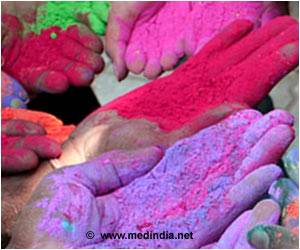
‘Celebrate Holi with a range of natural colors made from the comfort of your home from dried orange peels or sandalwood (for yellow), dried gulab or rose petals (red), dried beetroots (pink) and dried neem, spinach or mint leaves (which give green color).’
Tweet it Now
There are toxic chemicals like lead, copper sulfate, aluminium bromide, zinc, asbestos and mercury (to name a few) that are used to manufacture colored powders are extremely harmful. They can lead to temporary blindness, asthma, renal problems and in the case of mercury sulfite (used to make the red color) it even causes skin cancer. There are possible chances of attracting allergic contact dermatitis over skin and allergic reaction to eye due to presence of these harmful chemicals. There may be red bumpy itchy skin rashes on and around exposed area. So does it mean no one will enjoy with colors, they will, definitely, yet with some adequate safety measures for the skin. Few awareness and cautious approach will make us enjoy Holi hassle free. It is not just the adults even children are vulnerable while playing with colors. It’s best to use home-made or natural colors for everybody but especially for children. Organic colors that are also eco-friendly are safer than any chemical artificial colors. Wet colors can be more harmful especially for young children, as they penetrate the skin more deeply. We must keep plenty of water nearby. In case of irritation to eye or skin we should wash the area gently and thoroughly with water. One should wear loose cotton clothes and cover the body as much possible. It is the duty of parents to help their wards maintain a safe distance from harmful chemicals present in colors and device methods to enjoy more aesthetically and organically.
Artificial colors have strong acidic or alkaline component can cause irritant contact dermatitis even burning of area of contact which can even change texture or color of the skin. Most dangerous of all are the colors with metallic component which feel like painting when applied over skin. Beside allergy they can be absorbed in the body and damage liver and kidney.
The real problem arises, when one must remove the colors after the festivities. People damage their skin in haste to remove the color from skin with vigorous rubbing. While some people prefer using soap or face wash, it may have ill-effects. It is necessary to wipe off the color with moist cotton wool. We must avoid washing face with soap immediately, because soap has alkaline content and causes further dryness. Instead, we must use a cleansing cream or lotion, apply and massage it on the face before stepping out to play. Girls must tie their hair in a bun and also cover it with bandana or caps. Pregnant women and small children must avoid playing with colors. Vigorous activities and harmful colors might be harmful to the baby in the womb, and could even lead to premature delivery, miscarriage or birth defects.
Researchers warn that Holi is no less an environmental hazard than Diwali. And they substantiate their claim with studies that show colors have an adverse impact on the water and soil. These colors are highly structured polymers and are very difficult to decompose biologically, which also prove to be threat to human health and to the flora and fauna in the long run.
Advertisement
Source-Medindia











